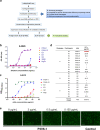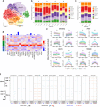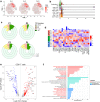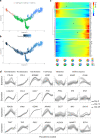Integrated single-cell analysis revealed immune dynamics during Ad5-nCoV immunization
- PMID: 34373443
- PMCID: PMC8352953
- DOI: 10.1038/s41421-021-00300-2
Integrated single-cell analysis revealed immune dynamics during Ad5-nCoV immunization
Abstract
Coronavirus disease 2019 (COVID-19), driven by SARS-CoV-2, is a severe infectious disease that has become a global health threat. Vaccines are among the most effective public health tools for combating COVID-19. Immune status is critical for evaluating the safety and response to the vaccine, however, the evolution of the immune response during immunization remains poorly understood. Single-cell RNA sequencing (scRNA-seq) represents a powerful tool for dissecting multicellular behavior and discovering therapeutic antibodies. Herein, by performing scRNA/V(D)J-seq on peripheral blood mononuclear cells from four COVID-19 vaccine trial participants longitudinally during immunization, we revealed enhanced cellular immunity with concerted and cell type-specific IFN responses as well as boosted humoral immunity with SARS-CoV-2-specific antibodies. Based on the CDR3 sequence and germline enrichment, we were able to identify several potential binding antibodies. We synthesized, expressed and tested 21 clones from the identified lineages. Among them, one monoclonal antibody (P3V6-1) exhibited relatively high affinity with the extracellular domain of Spike protein, which might be a promising therapeutic reagent for COVID-19. Overall, our findings provide insights for assessing vaccine through the novel scRNA/V(D)J-seq approach, which might facilitate the development of more potent, durable and safe prophylactic vaccines.
© 2021. The Author(s).
Conflict of interest statement
The authors declare no competing interests.
Figures






Similar articles
-
Microneedle array delivered recombinant coronavirus vaccines: Immunogenicity and rapid translational development.EBioMedicine. 2020 May;55:102743. doi: 10.1016/j.ebiom.2020.102743. Epub 2020 Apr 2. EBioMedicine. 2020. PMID: 32249203 Free PMC article.
-
Single-Dose Immunization With a Chimpanzee Adenovirus-Based Vaccine Induces Sustained and Protective Immunity Against SARS-CoV-2 Infection.Front Immunol. 2021 Jun 28;12:697074. doi: 10.3389/fimmu.2021.697074. eCollection 2021. Front Immunol. 2021. PMID: 34262569 Free PMC article.
-
Heterologous immunization with Covishield and Pfizer vaccines against SARS-CoV-2 elicits a robust humoral immune response.J Infect Dev Ctries. 2021 May 31;15(5):653-656. doi: 10.3855/jidc.15368. J Infect Dev Ctries. 2021. PMID: 34106888
-
Dynamic blood single-cell immune responses in patients with COVID-19.Signal Transduct Target Ther. 2021 Mar 6;6(1):110. doi: 10.1038/s41392-021-00526-2. Signal Transduct Target Ther. 2021. PMID: 33677468 Free PMC article.
-
What are the roles of antibodies versus a durable, high quality T-cell response in protective immunity against SARS-CoV-2?Vaccine X. 2020 Dec 11;6:100076. doi: 10.1016/j.jvacx.2020.100076. Epub 2020 Aug 28. Vaccine X. 2020. PMID: 32875286 Free PMC article. Review.
Cited by
-
Comparative global B cell receptor repertoire difference induced by SARS-CoV-2 infection or vaccination via single-cell V(D)J sequencing.Emerg Microbes Infect. 2022 Dec;11(1):2007-2020. doi: 10.1080/22221751.2022.2105261. Emerg Microbes Infect. 2022. PMID: 35899581 Free PMC article.
-
Vaccines for COVID-19: A Systematic Review of Immunogenicity, Current Development, and Future Prospects.Front Immunol. 2022 Apr 27;13:843928. doi: 10.3389/fimmu.2022.843928. eCollection 2022. Front Immunol. 2022. PMID: 35572592 Free PMC article.
-
Clonal structure and the specificity of vaccine-induced T cell response to SARS-CoV-2 Spike protein.Front Immunol. 2024 Apr 2;15:1369436. doi: 10.3389/fimmu.2024.1369436. eCollection 2024. Front Immunol. 2024. PMID: 38629062 Free PMC article.
-
Characterizing the cellular and molecular variabilities of peripheral immune cells in healthy recipients of BBIBP-CorV inactivated SARS-CoV-2 vaccine by single-cell RNA sequencing.Emerg Microbes Infect. 2023 Dec;12(1):e2187245. doi: 10.1080/22221751.2023.2187245. Emerg Microbes Infect. 2023. PMID: 36987861 Free PMC article.
-
What Happens to the Immune System after Vaccination or Recovery from COVID-19?Life (Basel). 2021 Oct 29;11(11):1152. doi: 10.3390/life11111152. Life (Basel). 2021. PMID: 34833028 Free PMC article. Review.
References
-
- COVID-19 Dashboard by the Center for Systems Science and Engineering (CSSE) at Johns Hopkins University (JHU), https://coronavirus.jhu.edu/map.html (2021).
Grants and funding
- 81722034/National Natural Science Foundation of China (National Science Foundation of China)
- 81988101/National Natural Science Foundation of China (National Science Foundation of China)
- 81802878/National Natural Science Foundation of China (National Science Foundation of China)
- 81670015/National Natural Science Foundation of China (National Science Foundation of China)
- 2018ZX09101002/Ministry of Science and Technology of the People's Republic of China (Chinese Ministry of Science and Technology)
LinkOut - more resources
Full Text Sources
Miscellaneous

